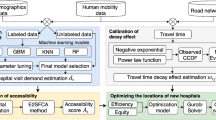Abstract
The degree to which locational complexity and geographical complexity is represented in a location model is a critical decision that influences the quality of the application. Criteria which can be used to guide these decisions are presented and research that would better inform these decisions is described.
Similar content being viewed by others
References
S. Angel and G.M. Hyman,Urban Fields, (Pion, London, 1976).
B. Ayeni, G. Rushton and M.L. McNulty, Improving the geographical accessibility of health care in rural areas: A Nigerian case study, Soc. Sci. Med. 10 (1987) 1083.
J. Beaumont, Location-Allocation problems in a plane: A review of some models, Soc. Econ. Pl. Sci. 15 (1981) 217.
M.L. Brandeau and R.C. Larson, Extending and applying the hypercube queueing model to deploy ambulances in Boston, TIMS Stud. Man. Sci. 22 (1986) 121.
P. Casillas, Data aggregation and thep-median problem in continuous space, in:Spatial Analysis and Location-Allocation Models, eds. A. Ghosh and G. Rushton (Van Nostrand Reinhold, New York, 1987) pp. 327–344.
A. Charnes, W.W. Cooper and E. Rhodes, Measuring the efficiency of decision making units, Eur. J. Oper. Res. 2 (1978) 429.
L. Cooper, The transportation-location problem, Oper. Res. 20 (1972) 94.
T. Crackel, The linkage of data describing overlapping geographical units — A second iteration, Historical Methods Newsletter 8 no. 3 (1975) 146.
J.R. Current and D.A. Schilling, Elimination of source A and B errors inp-median location problems, Geog. Anal. 19 (1987) 95.
M.S. Daskin, K. Hogan and C. ReVelle, Integration of multiple, excess, backup, and expected covering models, Env. And Pl. B., Vol. 15 (1988) 15.
P. Densham and G. Rushton, Decision support systems for locational planning, in:Behavioural Modelling Approaches in Geography eds. H. Timmermans and R.G. Golledge (Croom Helm, London, 1987) pp. 56–90.
D.J. Eaton, H.M.L. Sanchez, R.R. Lantigua and J. Morgan, Determining ambulance deployment in Santo Domingo, Dominican Republic, Jour. Oper. Res. Soc. 37 (1986) 113.
M.J. Farrell, The measure of productive efficiency, J. Roy. Stat. Soc. Series A (General) Part III (1957) 253.
B. Fischoff and B. Goitein, The informal use of formal models, Acad. Man. Rev. 9 (1984) 505.
M.F. Goodchild, The aggregation problem in location-allocation, Geog. Anal. 11 (1979) 240.
M.F. Goodchild and B.H. Massam, Some least-cost models of spatial administrative systems in Southern Ontario, Geografiska Annaler 52 (1969) 86.
P. Gould, S. Nordbeck and B. Rystedt, Data sensitivity and scale experiments in locating multiple facilities, in:Multiple Location Analysis eds. G. Tornqvist, S. Nordbeck, B. Rystedt and P. Gould, Lund Studies in Geography Series C, General, Mathematical and Regional Geography no. 12, (Lund, Sweden, 1971) pp. 67–84.
E.L. Hillsman,Heuristic Solutions to Location-Allocation Problems: A User's Guide to ALLOC IV, V, and VI, monograph 7 (Department of Geography, University of Iowa, Iowa City, IA).
E.L. Hillsman, Thep-median structure as a unified linear model for location-allocation analysis, Env. & Pl. A 16 (1984) 305.
E.L. Hillsman and R. Rhoda, Errors in measuring distances from populations to service centers, Annal. Reg. Sci. 12 (1978) 74.
C.A. Holloway, D.A. Wehrung and M.P. Zeitlin, An interactive procedure for the school boundary problem with declining enrollment, Oper. Res. 23 (1975) 191.
L.D. Hopkins, Evaluation of methods for exploring ill-defined problems, Env. & Pl. B 11 (1984) 339.
P.J. Kolesar, Travel time and travel distance models, in:Fire Deployment Analysis eds. W.E. Walker, J.M. Chaiken and E.J. Ignall (North-Holland, New York, 1979) pp. 157–201.
N.S.-N. Lam, Spatial interpolation methods: A review, The Amer. Cart. 10 (1983) 129.
R.C. Larson, Approximating the performance of urban emergency service systems, Oper. Res. 23 (1975) 845.
R.C. Larson and K.A. Stevenson, On insensitivities in urban redistricting and facilty location, Oper. Res. 20 (1972) 595.
E.E. Leamer, Locational equilibria, J. Reg. Sci. 8 (1968) 229.
R. Lineberry,Equality and Public Policy (Sage, Beverly Hills, 1977).
B.I. Logan, Evaluating public policy costs in rural development planning: the example of health care in Sierra Leone, Econ. Geog. 61 (1985) 144.
R.F. Love, J.G. Morris and G.O. Wesolowsky,Facilities Location Models and Methods, (Elsevier Science Publishing Co, New York, 1988).
L. Mayhew,Urban Hospital Location (Allen & Unwin, London, 1986).
S. McLafferty, Constraints on distributional equity in the location of public services, Pol. Geog. Ort. 3 (1984) 33.
S. McLafferty and A. Ghosh, Issues in measuring differential access to public services, Urban Stud. 19 (1982) 383.
S.G. Nichols and R. Honey, An application of a location-allocation model to evaluate and improve geographic accessibility of vocational training centers in Jordan, in:Proc. Ninth Annual Applied Geography Conference (1986).
S. Park, Performance of successively complex rules for locational decision-making, Ann. Oper. Res. 18 (1989) this volume.
R.A. Reid, K.L. Ruffing and H.L. Smith, Managing medical supply logistics among health workers in Ecuador, Soc. Sci. Med. 22 (1986) 9.
G. Rushton, Map transformations of point patterns: Central place patterns in areas of variable population density,Papers Regional Science Association 28 (1972) 111.
G. Rushton, Use of location-allocation models for improving the geographical accessibility of rural services in developing countries, Intl. Reg. Sci. Rev. 9 (1984) 217.
G. Rushton, Selecting the objective function in location-allocation analyses, in:Spatial Analysis and Location-Allocation Models, eds. A. Ghosh and G. Rushton (Van Nostrand Reinold, New York, 1987) pp. 345–364.
J.B. Schneider, Solving urban location problems: human intuition versus the computer, J. Amer. Inst. Pl. 37 (1971) 95.
H.D. Sherman, Hospital efficiency measurement and evaluation: empirical test of a new technique, Med. Care 22 (1984) 922.
R. Stock, Distance and the utilization of health facilities in rural Nigeria, Soc. Sci. Med. 9 (1983) 563.
A.J. Swersey and E.J. Ignall, eds.,Delivery of Urban Services, TIMS Studies in the Management Sciences 22 (North-Holland, New York, 1986).
M.B. Teitz and P. Bart, Heuristic methods for estimating the generalized vertex median of a weighted graph, Oper. Res. 16 (1968) 955.
W.R. Tobler, Smooth pycnophylactic interpolation for geographic regions, J. Amer. Stat. Assn. 74 (1979) 519.
R.J. Volkema, Problem formulation in planning and design, Man. Sci. 29 (1983) 639.
Author information
Authors and Affiliations
Rights and permissions
About this article
Cite this article
Rushton, G. Applications of location models. Ann Oper Res 18, 25–42 (1989). https://doi.org/10.1007/BF02097794
Issue Date:
DOI: https://doi.org/10.1007/BF02097794




